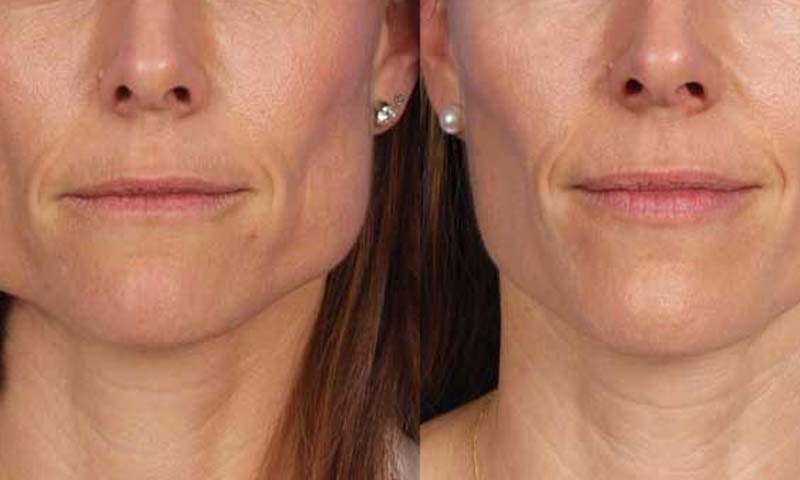Masseter reduction, also referred to as facial slimming, jawline slimming or V-line, is a facial rejuvenation procedure used to produce a “heart-shaped” face. It helps individuals slim the jawline, leading to a balanced, natural-looking facial appearance. To better understand masseter reduction and whether this facial rejuvenation treatment is right for you, let’s examine eight questions about the procedure.
- What Is Masseter Reduction?
Masseter reduction is intended for individuals dealing with an enlarged masseter muscle; this muscle helps facilitate chewing and is located in the rear portion of the cheek. Sometimes, a masseter muscle becomes enlarged due to ongoing clenching or grinding of the teeth, which may occur while a person sleeps. People who frequently chew gum may be prone to masseter muscle enlargement, too.
An enlarged masseter muscle may also cause an asymmetrical facial appearance, along with a square jawline that fails to complement an individual’s cheeks, eyes and other facial features. In this instance, an individual may undergo masseter reduction to enhance his or her facial appearance.
- Can Masseter Reduction Treat TMJ Disorder?
Temporomandibular joint (TMJ) disorder causes pain in the joints and muscles used to move the jaw and severe headaches on the side of the head. Fortunately, TMJ is sometimes treated with masseter reduction.
Masseter reduction involves the use of injectable Botox treatments into one or both masseter muscles. This weakens the force of these muscles to relieve TMJ pain. In some cases, masseter reduction helps individuals alleviate TMJ pain for up to six months.
3. Why Is Masseter Reduction Becoming a Popular Procedure for Facial Rejuvenation?
A wide or boxy facial appearance is a problem for many patients. Yet finding a safe, effective way to treat this issue is sometimes difficult. Now, masseter reduction provides men and women with a treatment to address facial asymmetry – without the need to go under the knife.
Masseter reduction is a non-surgical procedure that helps patients quickly improve facial symmetry. Patients often see results within just a few weeks of their first masseter reduction treatment session. Additionally, patients can maintain these results for an extended period of time.
Let’s not forget about the “selfie culture” that permeates social media, either. People who want to capture the perfect selfie may struggle to do so if they are dealing with an asymmetrical facial appearance. Thanks to masseter reduction, however, men and women can seamlessly treat an asymmetrical facial appearance. And as a result, these individuals can show off their beautiful faces on social media any time they choose.
- How Is Masseter Reduction Performed?
Botox is commonly used during a non-surgical masseter reduction. Botox treatment involves a series of Botox injections to reduce the activity of the masseter muscles, and therefore their size. It also helps patients address teeth clinching and grinding that otherwise causes masseter muscle enlargement.
The amount of Botox injected into the masseter muscle varies based on the patient. Meanwhile, Botox injections may be required over the course of several weeks to ensure the best results.
5. Who Is the Ideal Candidate for Masseter Reduction?
Ultimately, masseter reduction helps an individual achieve a softer, smoother jawline. The ideal candidate for masseter reduction often deals with one or more enlarged masseter muscles. He or she may also be dealing with a square jawline.
- Does Masseter Reduction Work?
Masseter reduction often helps patients achieve a heart-shaped face in just weeks. Plus, the procedure is generally pain-free and requires little to no downtime.
The side effects associated with Botox injections are usually minimal, too. Common Botox side effects include:
- Itching
- Headache
- Back or neck pain
- Muscle stiffness
- Nausea
- Stomach pain
- Loss of appetite
- Muscle weakness
Botox side effects may disappear on their own within a few days of treatment. If an individual experiences long-lasting Botox side effects, he or she should contact a facial plastic and reconstructive surgeon immediately.
7. Who Can Perform Masseter Reduction?
It is important to find an expert facial plastic and reconstructive surgeon to perform masseter reduction. This surgeon will explain masseter reduction, how it works and its benefits. He or she will also evaluate a patient prior to treatment to determine if he or she is a good candidate for masseter reduction.
- What Factors Should You Consider Before Masseter Reduction?
Key factors to consider before masseter reduction include:
- Facial Rejuvenation Treatment Goals: Masseter reduction is not a “quick-fix” facial rejuvenation treatment; as such, an individual should establish realistic expectations before undergoing the procedure.
- Cost: The cost of masseter reduction varies based on the number of treatment sessions, the surgeon performing the procedure and other factors. To determine the cost of masseter reduction, it often helps to meet with a facial plastic and reconstructive surgeon.
- Surgeon: The surgeon a person selects for masseter reduction can have far-flung effects on treatment results. Thus, an individual should look for a surgeon who has comprehensive masseter reduction expertise and can help him or her achieve the best-possible treatment results.
Clearly, there is a lot to consider relative to jawline slimming. With an informed approach to masseter reduction, an individual can determine if the procedure matches his or her expectations. If the answer is yes, this individual can then pursue masseter reduction performed by an expert facial plastic and reconstructive surgeon.



















